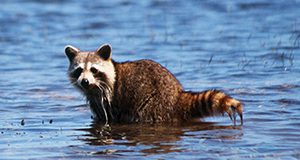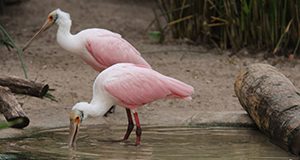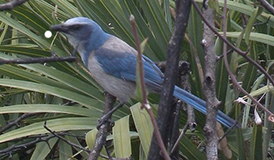Diseases carried by northern raccoons present significant health hazards to both people and pets. This 7-page fact sheet written by Caitlin Jarvis and Mathieu Basille and published by the UF/IFAS Department of Wildlife Ecology and Conservation is part of a series addressing health hazards associated with raccoons. It describes the raccoon roundworm and the disease it causes, baylisascariasis, which normally causes little or no trouble to raccoons but in severe cases can make people and their pets very sick. Sick wild animals can act tame, but do not approach! Contact animal control or a wildlife rehabilitator if an animal seems to be behaving abnormally or if you suspect it is sick.
https://edis.ifas.ufl.edu/uw480
Tag: Mathieu Basille
Facts about Wildlife Diseases: Raccoon-Borne Pathogens of Importance to Humans—Parasites

Diseases carried by northern raccoons present significant health hazards to both people and pets. This 7-page fact sheet written by Caitlin Jarvis and Mathieu Basille and published by the UF/IFAS Department of Wildlife Ecology and Conservation is part of a series addressing health hazards associated with raccoons. It describes the most important internal and external parasites associated with raccoons. Sick wild animals can act tame, but do not approach! Contact animal control or a wildlife rehabilitator if an animal seems to be behaving abnormally or if you suspect it is sick.
https://edis.ifas.ufl.edu/uw479
Facts about Wildlife Diseases: Raccoon-Borne Pathogens of Importance to Humans—Viruses and Bacteria
Diseases carried by northern raccoons present significant health hazards to both people and pets. This 7-page fact sheet written by Caitlin Jarvis, Samantha M. Wisely, and Mathieu Basille and published by the UF/IFAS Department of Wildlife Ecology and Conservation is part of a series addressing health hazards associated with raccoons. It describes rabies, canine distemper, feline distemper, canine parvovirus, salmonellosis, and several other raccoon-borne viral and bacterial diseases of concern to people and their pets. Sick wild animals can act tame, but do not approach! Contact animal control or a wildlife rehabilitator if an animal seems to be behaving abnormally or if you suspect it is sick.
https://edis.ifas.ufl.edu/uw478
Using iNaturalist to Contribute Your Nature Observations to Science.

iNaturalist is one of the most popular citizen science data portals in the world. Citizens can submit pictures of biological observations to an online data base to be reviewed by the rich online community and used for important biodiversity research around the world. Users can use the iNaturalist ap to plan community projects and bioblitzes and learn more about species identification and biodiversity. In this 5-page fact sheet, authors Matthew Earl Boone and Mathieu Basille explain how observations are vetted and used and give a step by step guide to get started! Published by the UF/IFAS Department of Wildlife Ecology and Conservation.
http://edis.ifas.ufl.edu/uw458
BioBlitzes: Citizen Science for Biodiversity in Florida
This 5-page fact sheet written by Mathieu Basille and Kathryn Stofer and published by the UF/IFAS Wildlife Ecology and Conservation Department is the first of a series designed to help Extension faculty and others interested in hosting citizen-science events known as BioBlitzes. Together, these documents will assist organizers in launching events in their regions, recruiting participants, and sustaining the program over time. This document will focus on the background and purpose of BioBlitzes to help these hosts understand and share with potential participants and other stakeholders the importance and value of the events. Other documents will focus on the details of organizing the events and, for participants, why and how they can get involved.
http://edis.ifas.ufl.edu/uw449
Climate Changes, Shifting Ranges: Climate change effects on wildlife in the Florida Everglades and Keys
Where do the animals go when the sea rises? Learn the probable futures of Florida panthers and other south Florida wildlife in this 5-page fact sheet. Written by Larry Perez, James I. Watling, David Bucklin, Mathieu Basille, Frank J. Mazzotti, Stephanie Romañach, and Laura Brandt and published by the UF Department of Wildlife Ecology and Conservation, it explains how a changing climate could impact wild animals.
edis.ifas.ufl.edu/uw428
Considerations for Building Climate-Based Species Distribution Models
Climate plays an important role in the distribution of species. A given species may adjust to new conditions in-place, move to new areas with suitable climates, or go extinct. Scientists and conservation practitioners use mathematical models to predict the effects of future climate change on wildlife and plan for a biodiverse future. This 8-page fact sheet written by David N. Bucklin, Mathieu Basille, Stephanie S. Romañach, Laura A. Brandt, Frank J. Mazzotti, and James I. Watling and published by the Department of Wildlife Ecology and Conservation explains how, with a better understanding of species distribution models, we can predict how species may respond to climate change. The models alone cannot tell us how a certain species will actually respond to changes in climate, but they can inform conservation planning that aims to allow species to both adapt in place and (for those that are able to) move to newly suitable areas. Such planning will likely minimize loss of biodiversity due to climate change.
http://edis.ifas.ufl.edu/uw420




